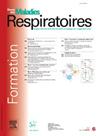Elexacaftor, Tezacaftor et Ivacaftor : évaluation de l’efficacité immédiate par spirométrie à domicile
IF 0.5
4区 医学
Q4 RESPIRATORY SYSTEM
引用次数: 0
Abstract
Introduction
Lors de l’initiation d’une trithérapie combinant elexacaftor, tezacaftor et ivacaftor (ETI) auprès de patients atteints de mucoviscidose, peu de données concernant les 2 premières semaines de traitement sont disponibles.
Méthodes
Dans cette étude prospective (NCT05599230), 20 patients âgés d’au moins 12 ans ont été recrutés lors de l’initiation du traitement. Une spirométrie à domicile (MIR Spirobank®) a été réalisée durant les 3 jours précédant le traitement puis quotidiennement pendant 14 jours, ainsi qu’un score de symptômes respiratoires (SSR) et un journal des événements vécus par chaque patient.
Résultats
L’âge moyen (± DS) des 20 patients était de 29,4 (± 11,1) ans et le VEMS moyen de 84,2 % (± 17,7). Par rapport à la moyenne des 3 jours précédant le traitement, l’amélioration du VEMS était significative à partir du 6e jour (J6). Le SSR se détériorait significativement à J1 (p < 0,05), puis s’améliorait à partir du J6. La qualité des mesures du VEMS à domicile était élevée (grade A : 81,2 %).
Conclusions
Lors d’un traitement par ETI, les bénéfices respiratoires ont été significatifs à partir du J6. Les effets secondaires cliniques perçus par le patient sont survenus au cours des 4 premiers jours de traitement.
Introduction
Following two weeks of application of the triple combination therapy of Elexacaftor (E), Tezacaftor (T), and Ivacaftor (I) known as ETI, substantial pulmonary improvement in patients with cystic fibrosis is well-documented. However, few detailed data are available on the action of this treatment over the course of these first 14 days.
Methods
In this prospective study (NCT05599230), 20 patients aged ≥ 12 years, all of them eligible for ETI, were recruited at the initiation of treatment. Home spirometry (MIR Spirobank®) was performed during the three days preceding the start of treatment and then daily for 14 days, while a respiratory symptom score (RSS) was calculated and a log maintained concerning the events experienced by each patient.
Results
Mean age (± SD) of the 20 patients was 29.4 (± 11.1) years, mean FEV1 was 84.2% (± 17.7), and the mean BMI z-score was 0.18 (± 0.82). Thirteen of them were already on modulators. When compared to the average scores recorded for the three days preceding the start of treatment, FEV1 improvement became significant from the 6th day (D6). After having significantly worsened on D1 (P < 0.05), the RSS improved from D6 onwards. The quality of home FEV1 measurements was high (grade A: 81.2%).
Conclusions
Under ETI treatment, respiratory benefits were significant from D6. The side effects most commonly perceived by the patients occurred during the first four days of treatment. While daily monitoring of home spirometry could indeed be a valuable tool in follow-up of patients with cystic fibrosis, its administration requires suitable and sustained training.
[elexaftor, Tezacaftor和Ivacaftor:使用家庭肺活量测定法进行即时疗效评估]。
经过两周Elexacaftor (E), Tezacaftor (T)和Ivacaftor (I)的三联治疗,即ETI,囊性纤维化患者的肺功能得到了显著改善。然而,关于这种治疗在最初14天内的作用的详细数据很少。方法:在这项前瞻性研究(NCT05599230)中,在治疗开始时招募20例年龄≥12岁的患者,所有患者均符合ETI条件。在治疗开始前3天进行家庭肺活量测定(MIR Spirobank®),然后连续14天每天进行一次,同时计算呼吸症状评分(RSS),并记录每位患者经历的事件。结果:20例患者平均年龄(±SD)为29.4(±11.1)岁,平均FEV1为84.2%(±17.7),平均BMI z-score为0.18(±0.82)。其中13人已经开始使用调制器了。与治疗开始前三天记录的平均得分相比,FEV1从第6天开始显著改善(D6)。结论:在ETI治疗下,患者从D6开始呼吸获益显著。患者最常感觉到的副作用发生在治疗的前四天。虽然每日监测家庭肺活量测定确实是囊性纤维化患者随访的一种有价值的工具,但其管理需要适当和持续的培训。
本文章由计算机程序翻译,如有差异,请以英文原文为准。
求助全文
约1分钟内获得全文
求助全文
来源期刊

Revue des maladies respiratoires
医学-呼吸系统
CiteScore
1.10
自引率
16.70%
发文量
168
审稿时长
4-8 weeks
期刊介绍:
La Revue des Maladies Respiratoires est l''organe officiel d''expression scientifique de la Société de Pneumologie de Langue Française (SPLF). Il s''agit d''un média professionnel francophone, à vocation internationale et accessible ici.
La Revue des Maladies Respiratoires est un outil de formation professionnelle post-universitaire pour l''ensemble de la communauté pneumologique francophone. Elle publie sur son site différentes variétés d''articles scientifiques concernant la Pneumologie :
- Editoriaux,
- Articles originaux,
- Revues générales,
- Articles de synthèses,
- Recommandations d''experts et textes de consensus,
- Séries thématiques,
- Cas cliniques,
- Articles « images et diagnostics »,
- Fiches techniques,
- Lettres à la rédaction.
 求助内容:
求助内容: 应助结果提醒方式:
应助结果提醒方式:


